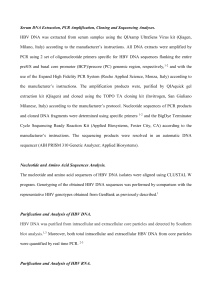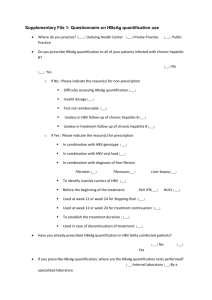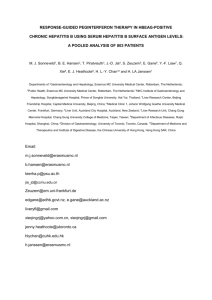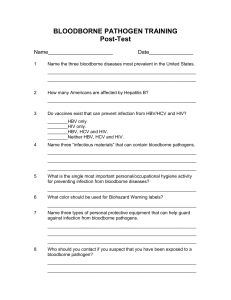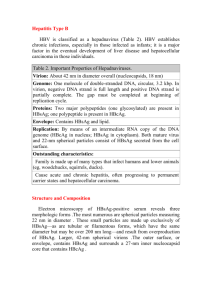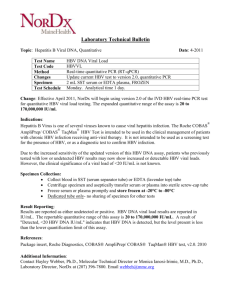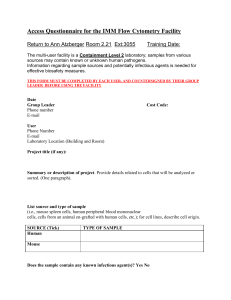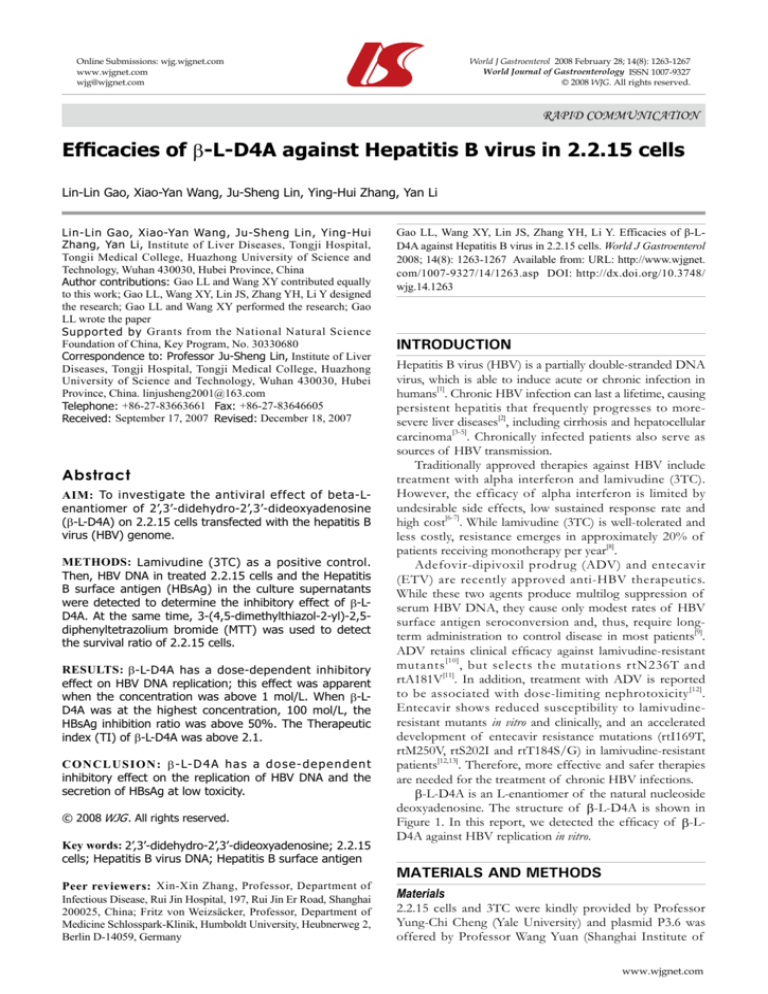
World J Gastroenterol 2008 February 28; 14(8): 1263-1267
World Journal of Gastroenterology ISSN 1007-9327
© 2008 WJG. All rights reserved.
Online Submissions: wjg.wjgnet.com
www.wjgnet.com
wjg@wjgnet.com
RAPID COMMUNICATION
Efficacies of β-L-D4A against Hepatitis B virus in 2.2.15 cells
Lin-Lin Gao, Xiao-Yan Wang, Ju-Sheng Lin, Ying-Hui Zhang, Yan Li
Lin-Lin Gao, Xiao-Yan Wang, Ju-Sheng Lin, Ying-Hui
Zhang, Yan Li, Institute of Liver Diseases, Tongji Hospital,
Tongii Medical College, Huazhong University of Science and
Technology, Wuhan 430030, Hubei Province, China
Author contributions: Gao LL and Wang XY contributed equally
to this work; Gao LL, Wang XY, Lin JS, Zhang YH, Li Y designed
the research; Gao LL and Wang XY performed the research; Gao
LL wrote the paper
Supported by Grants from the National Natural Science
Foundation of China, Key Program, No. 30330680
Correspondence to: Professor Ju-Sheng Lin, Institute of Liver
Diseases, Tongji Hospital, Tongji Medical College, Huazhong
University of Science and Technology, Wuhan 430030, Hubei
Province, China. linjusheng2001@163.com
Telephone: +86-27-83663661 Fax: +86-27-83646605
Received: September 17, 2007 Revised: December 18, 2007
Abstract
AIM: To investigate the antiviral effect of beta-Lenantiomer of 2’,3’-didehydro-2’,3’-dideoxyadenosine
(β-L-D4A) on 2.2.15 cells transfected with the hepatitis B
virus (HBV) genome.
METHODS: Lamivudine (3TC) as a positive control.
Then, HBV DNA in treated 2.2.15 cells and the Hepatitis
B surface antigen (HBsAg) in the culture supernatants
were detected to determine the inhibitory effect of β-LD4A. At the same time, 3-(4,5-dimethylthiazol-2-yl)-2,5diphenyltetrazolium bromide (MTT) was used to detect
the survival ratio of 2.2.15 cells.
RESULTS: β-L-D4A has a dose-dependent inhibitory
effect on HBV DNA replication; this effect was apparent
when the concentration was above 1 mol/L. When β-LD4A was at the highest concentration, 100 mol/L, the
HBsAg inhibition ratio was above 50%. The Therapeutic
index (TI) of β-L-D4A was above 2.1.
CONCLUSION: β- L- D 4 A h a s a d o s e - d e p e n d e n t
inhibitory effect on the replication of HBV DNA and the
secretion of HBsAg at low toxicity.
© 2008 WJG . All rights reserved.
Key words: 2’,3’-didehydro-2’,3’-dideoxyadenosine; 2.2.15
cells; Hepatitis B virus DNA; Hepatitis B surface antigen
Peer reviewers: Xin-Xin Zhang, Professor, Department of
Infectious Disease, Rui Jin Hospital, 197, Rui Jin Er Road, Shanghai
200025, China; Fritz von Weizsäcker, Professor, Department of
Medicine Schlosspark-Klinik, Humboldt University, Heubnerweg 2,
Berlin D-14059, Germany
Gao LL, Wang XY, Lin JS, Zhang YH, Li Y. Efficacies of β-LD4A against Hepatitis B virus in 2.2.15 cells. World J Gastroenterol
2008; 14(8): 1263-1267 Available from: URL: http://www.wjgnet.
com/1007-9327/14/1263.asp DOI: http://dx.doi.org/10.3748/
wjg.14.1263
INTRODUCTION
Hepatitis B virus (HBV) is a partially double-stranded DNA
virus, which is able to induce acute or chronic infection in
humans[1]. Chronic HBV infection can last a lifetime, causing
persistent hepatitis that frequently progresses to moresevere liver diseases[2], including cirrhosis and hepatocellular
carcinoma[3-5]. Chronically infected patients also serve as
sources of HBV transmission.
Traditionally approved therapies against HBV include
treatment with alpha interferon and lamivudine (3TC).
However, the efficacy of alpha interferon is limited by
undesirable side effects, low sustained response rate and
high cost[6-7]. While lamivudine (3TC) is well-tolerated and
less costly, resistance emerges in approximately 20% of
patients receiving monotherapy per year[8].
Adefovir-dipivoxil prodrug (ADV) and entecavir
(ETV) are recently approved anti-HBV therapeutics.
While these two agents produce multilog suppression of
serum HBV DNA, they cause only modest rates of HBV
surface antigen seroconversion and, thus, require longterm administration to control disease in most patients[9].
ADV retains clinical efficacy against lamivudine-resistant
mutants [10] , but selects the mutations rtN236T and
rtA181V[11]. In addition, treatment with ADV is reported
to be associated with dose-limiting nephrotoxicity [12].
Entecavir shows reduced susceptibility to lamivudineresistant mutants in vitro and clinically, and an accelerated
development of entecavir resistance mutations (rtI169T,
rtM250V, rtS202I and rtT184S/G) in lamivudine-resistant
patients[12,13]. Therefore, more effective and safer therapies
are needed for the treatment of chronic HBV infections.
β-L-D4A is an L-enantiomer of the natural nucleoside
deoxyadenosine. The structure of β-L-D4A is shown in
Figure 1. In this report, we detected the efficacy of β-LD4A against HBV replication in vitro.
MATERIALS AND METHODS
Materials
2.2.15 cells and 3TC were kindly provided by Professor
Yung-Chi Cheng (Yale University) and plasmid P3.6 was
offered by Professor Wang Yuan (Shanghai Institute of
www.wjgnet.com
1264
ISSN 1007-9327
N
N
N
World J Gastroenterol
Figure 1 Chemical structure of β-L-D4A.
NH2
N
CN 14-1219/R
O
CH2OH
Biochemistry, Chinese Academy of Sciences). β-L-D4A
was synthesized by the Department of Pharmacology
of Wuhan University. G418 and MTT were purchased
from Sigma (USA) and DMEM was from Gibco (USA).
Fetal bovine serum was purchased from Hyclone (USA),
random primers were purchased from Takara (Japan) and
DIG-labeled dUTP was purchased from Roche (Germany).
An EIA Kit for the detection of HBsAg was purchased
from Kehua (Shanghai). HBV DNA fluorescent quantified
PCR (FQ-PCR) Kit was purchased from Biotronics (USA).
Methods
Cell culture: 2.2.15 cells were maintained in DMEM
(supplemented with 10% fetal bovine serum, 200 g/mL
G418, 2 mmol/L glutamine, 50 U of penicillin per
milliliter and 50 μg of streptomycin per milliliter) at 37℃
and 5% CO2. The medium was changed every three days.
Intracellular HBV DNA analysis: 2.2.15 cells were
digested by parenzyme, seeded at a density of 1 × 105
cells per well on 24-well plates and maintained in 1.5 mL
DMEM at 37℃ and 5% CO2 for 48 h. Then, 2.2.15 cells
were treated with freshly prepared medium containing
β-L-D4A or 3TC. The following concentrations were used:
0.0001, 0.001, 0.01, 0.1, 1, 10, 100 mol/L. Negative control
cells were treated with DMEM only. Media were changed
every three days; on day 8, both the supernatants and cells
were collected and stored at -20℃.
Then, the cells were lysed at room temperature with
1 mL of lysis buffer [50 mmol/L Tris-HCl (pH 7.4), 150
mmol/L NaCl, 5 mmol/L MgCl2, 0.2% Nonidet P-40].
Removal of cellular debris was accomplished by a 5-min
microcentrifuge spin at 16 000 r/min. Lysates were then
incubated with 20% PEG 8000 and 1 mol/L NaCl at room
temperature for 2 h, followed by a 1-min microcentrifuge
spin at 16 000 r/min. The resulting pellets containing
HBV core particles were resuspended in solution added
with proteinase K [10 mmol/L Tris (pH 7.6), 10 mmol/L
EDTA, 0.25% SDS, 1 mg/mL proteinase K] at 56℃ for
2 h, followed by extraction with phenol-chloroform and
ethanol precipitation. Nucleic acids were dissolved in
ddH2O, electrophoresed through 1% agarose, transferred
to a positively charged nylon membrane and hybridized to
a probe, which was prepared from a full-length HBV DNA
genome template excised from plasmid P3.6 and DIGlabeled using a random primer. Then, the membrane was
incubated with anti-DIG and developed with NBP/ BCIP.
The concentration of extracted HBV DNA was also
determined by real-time fluorescent quantitative Polymerase
Chain Reaction(FQ-PCR). The inhibition ratio was
calculated according to the following formula: inhibition
www.wjgnet.com
February 28, 2008
Volume 14
Number 8
ratio = (HBV DNA concentration of negative control HBV DNA concentration of experimental group)/HBV
DNA concentration of negative control × 100%. Then, the
50% inhibition concentration (IC50) was calculated according
to the Reed-Muench method[14].
Detection of HBsAg: 2.2.15 cells were treated with
antiviral compounds and lysed as described above. The
collected supernatants were detected using an EIA Kit for
the detection of HBsAg according to the manufacturer’s
instructions, and A 450 was observed. Inhibition ratio
to HBsAg (%) = (A 450 of negative control -A 450 of
experimental group) / (A450 of negative control -A450 of
blank control) × 100%.
Analysis of cellular toxicity: MTT assays were used to
detect the survival rates of 2.2.15 cells[15]. Briefly, 2.2.15
cells were seeded at a density of 1 × 105 cells per well
on 24-well plates and treated with media containing β-LD4A or 3TC of different concentrations. The following
concentrations were used: 1000, 500, 250, 125, 62.5 and
31.25 mol/L. Three days later, the supernatants were
discarded and 2 mL of MTT (1 mg/mL) was added
per well. After incubation at 37℃ and 5% CO2 for 4 h,
the supernatants were discarded and 2 mL of acidified
isopropanol (isopropanol:HCl = 500:1.68) was added
per well. The survival ratio of 2.2.15 cells (%) = (A 570
of experimental group/A 570 of negative control) ×
100%. Then, the 50% toxicity dose (TD50) was calculated
according to the Reed-Muench method.
Evaluation of treatment: Therapeutic index (TI) =
TD50/IC50. If the TI is above 2.1, the compound is high in
efficacy and low in cellular toxicity. If TI is between 2 and 1,
the compound is both considerably effective and toxic. If
TI is below 1, the compound is low in efficacy, but high in
cellular toxicity.
Statistics analysis
All statistics were analyzed using SPSS10.0, and differences
were considered significant when the P value was < 0.05.
RESULTS
β -L-D4A inhibits the replication of HBV DNA
To investigate the potential of β-L-D4A to inhibit HBV
viral replication, HBV DNA was isolated from treated
2.2.15 cells and detected by Southern hybridization.
Figure 2 shows that the production of HBV DNA lessened
following treatment of cells with β-L-D4A; this effect
became more notable as the dose of β-L-D4A increased. A
similar phenomenon was observed in cells treated with 3TC.
The concentration of HBV DNA in 2.2.15 cells was
determined by real-time fluorescent quantitative PCR. As
shown in Figure 3, β-L-D4A had an apparent inhibitory
effect on the concentration of HBV DNA (P > 0.05 when
compared to that of 3TC). Calculated according to the
Reed-Muench method, the IC50 values of β-L-D4A and
3TC were 0.61 mol/L and 0.30 mol/L, respectively.
Gao LL et al . Efficacies of β-L-D4A against HBV in 2.2.15 cells
100
10
1
0.1
0.01
100
0.001
10
1
0.1
0.01
0.001
0.0001
mmol/L
1265
Table 1 TIs of b-L-D4A and 3TC
Group
IC50 (mmol/L)
TD50 (mmol/L)
TI
0.61
0.30
417
243
683
810
β-L-D4A
3TC
TI: Therapeutic index.
Control 1
2
3
4
5
6
7
8
9
10
11 12 13 14
Figure 2 Southern analysis of the HBV DNA extracted from 2.2.15 cells. Lane
control: HBV DNA extracted from untreated 2.2.15 cells; Lane 1-7: HBV DNA
extracted from 2.2.15 cells treated with β-L-D4A; Lane 8-14: HBV DNA extracted
from 2.2.15 cells treated with 3TC.
Inhibition ratio (%)
100
β-L-D4A
3TC
80
60
40
20
0
1
00
0.0
01
0.0
1
0.0
0.1
1
0
10
10
Compound concentration (mmol/L)
Figure 3 The inhibition ratio to HBV DNA.
Inhibition ratio (%)
60
β-L-D4A
50
3TC
40
30
20
10
0
1
00
0.0
1
1
01
10
0.1
0.0
0.0
Compound concentration (mmol/L)
0
10
Figure 4 The inhibition ratio to HBsAg.
β -L-D4A inhibits the secretion of HBsAg
Following treatment of 2.2.15 cells with antiviral
compounds for eight days, HBsAg was detected in the
medium. As shown in Figure 4, when the concentration
of β-L-D4A was 100 mol/L, the HBsAg inhibition ratio
was above 50%. However, the HBsAg inhibition ratio with
3TC was less than 40% even at the highest concentration.
Cellular toxicity of β -L-D4A
The cellular toxicity of both compounds was not evident
at drug concentrations below 125 mol/L. The survival
ratios were less than 50% when the drug concentrations
were as high as 1000 mol/L, with both compounds.
Calculated according to the Reed-Muench method, the
TD50 values of β-L-D4A and 3TC were 417 mol/L and
243 mol/L, respectively.
Evaluation of treatment
Table 1 shows the TIs for both β-L-D4A and 3TC were
above 2.1. This means that these two compounds are high
in efficacy and low in cellular toxicity.
DISCUSSION
HBV infection is one of the most prevalent viral diseases
in the world and more than 350 million people are
chronically infected [16,17], with about 1 million deaths
annually [18]. In order to screen anti-HBV compounds,
researchers often purify HBV DNA polymerase. However,
the purification procedure is very complicated and the
quantity of polymerase is not satisfying[19,20]. 2.2.15 cells
can stably replicate HBV DNA and express HBsAg; thus,
they can be used as an ideal cell model to screen the in vitro
antiviral efficacy of medicines[21,22].
In this study, we found that β -L-D4A has a dosedependent inhibitory effect on HBV DNA replication
that is apparent when the concentration is above 1 mol/L.
However, the inhibition of the secretion of HBsAg was not
as pronounced as that of HBV DNA replication. When
β-L-D4A was at the highest concentration, 100 mol/L,
the HBsAg inhibition ratio was slightly above 50%. The
TI of β-L-D4A shows that it is high in efficacy and low in
toxicity, which indicates that β-L-D4A is a promising antiHBV compound.
β-L-D4A is a new type of L-nucleoside for which the
natural counterpart is deoxyadenosine. Although there
have been reports about L-nucleosides since 1960s, it was
only after about 30 years that the merits of L-nucleoside
became widely recognized[23-24]. Previous studies revealed
the bioactivities and securities of L-nucleoside analogues
were superior to their counterpart enantiomers[25-27]. β-L
3/(2R, 5S)-1,3-oxathiolane-cytidine (lamivudine, 3TC), a
typical L-nucleoside, was reported to be about 50 times
more effective than its D-enantiomer[28-30].
The mechanism of action of β-L-D4A is speculated to
be inhibition of HBV DNA polymerase and termination
of DNA replication. In order to confirm this speculation,
further study is necessary. It also remains to be seen whether
β-L-D4A is effective against lamivudine-resistant HBV
mutants and whether it will lead to HBV mutants resistant
to β-L-D4A. Besides, much work remains to be done to gain
a better understanding of the metabolism, toxicology and
pharmacokinetic parameters of this compound. Our studies
to date suggest β-L-D4A deserves further development as a
potential treatment for chronic HBV infection.
ACKNOWLEDGMENTS
We thank Professor Yung-Chi Cheng for the kind gift of
www.wjgnet.com
1266
ISSN 1007-9327
CN 14-1219/R
World J Gastroenterol
2.2.15 cells and 3TC. We also thank Professor Wang Yuan
for the plasmid P3.6.
COMMENTS
9
10
Background
Hepatitis B virus (HBV) is one of the causative agents of acute or chronic hepatitis
in humans, and there are an estimated 350 million persistently HBV-infected
carriers worldwide. Such prevalence of HBV demands the discovery of new
effective therapeutics for the treatment of acute and chronic infections.
Research frontiers
There have been articles studying the antiviral effects of Entecavir and Adefovir,
which are analogs of deoxyguanosine and deoxyadenosine, respectively. While
these two agents produce pronounced suppression of serum HBV DNA, they
cause only modest rates of HBV surface antigen seroconversion and even induce
resistant mutants. Thus, there is an urgent need to develop a new potent anti-HBV
drug.
Innovations and breakthroughs
In this study, we find that β-L-D4A has a dose-dependent inhibitory effect on the
replication of HBV DNA and the secretion of HBsAg at low toxicity.
11
12
13
14
Applications
The results of this study confirm the in vitro antiviral effect of β-L-D4A, which
indicates it is a promising new drug against HBV infection.
Terminology
β-L-D4A is an L-enantiomer of its natural nucleoside-deoxyadenosine.
15
16
17
Peer review
This study aimed to investigate the antiviral effect of β-L-D4A on 2.2.15 cell line
by comparing with 3TC. They found β-L-D4A has concentration-relative inhibitory
effect to HBV DNA replication and the therapeutic index of β-L-D4A was above 2.1.
It’s an interesting subject.
REFERENCES
1
2
3
4
5
6
7
8
Park SG, Jung G. Human hepatitis B virus polymerase
interacts with the molecular chaperonin Hsp60. J Virol 2001;
75: 6962-6968
Delaney WE 4th, Yang H, Miller MD, Gibbs CS, Xiong S.
Combinations of adefovir with nucleoside analogs produce
additive antiviral effects against hepatitis B virus in vitro.
Antimicrob Agents Chemother 2004; 48: 3702-3710
Jansen RW, Johnson LC, Averett DR. High-capacity in vitro
assessment of anti-hepatitis B virus compound selectivity by
a virion-specific polymerase chain reaction assay. Antimicrob
Agents Chemother 1993; 37: 441-447
Delmas J, Schorr O, Jamard C, Gibbs C, Trepo C, Hantz O,
Zoulim F. Inhibitory effect of adefovir on viral DNA synthesis
and covalently closed circular DNA formation in duck
hepatitis B virus-infected hepatocytes in vivo and in vitro.
Antimicrob Agents Chemother 2002; 46: 425-433
Lee WM. Hepatitis B virus infection. N Engl J Med 1997; 337:
1733-1745
Levine S, Hernandez D, Yamanaka G, Zhang S, Rose R,
Weinheimer S, Colonno RJ. Efficacies of entecavir against
lamivudine-resistant hepatitis B virus replication and
recombinant polymerases in vitro. Antimicrob Agents Chemother
2002; 46: 2525-2532
Hoofnagle JH, di Bisceglie AM. The treatment of chronic viral
hepatitis. N Engl J Med 1997; 336: 347-356
Lai CL, Dienstag J, Schiff E, Leung NW, Atkins M, Hunt C,
Brown N, Woessner M, Boehme R, Condreay L. Prevalence
and clinical correlates of YMDD variants during lamivudine
therapy for patients with chronic hepatitis B. Clin Infect Dis
2003; 36: 687-696
www.wjgnet.com
18
19
20
21
22
23
24
25
26
February 28, 2008
Volume 14
Number 8
Delaney WE 4th, Ray AS, Yang H, Qi X, Xiong S, Zhu Y, Miller
MD. Intracellular metabolism and in vitro activity of tenofovir
against hepatitis B virus. Antimicrob Agents Chemother 2006; 50:
2471-2477
Perrillo R, Hann HW, Mutimer D, Willems B, Leung N, Lee
WM, Moorat A, Gardner S, Woessner M, Bourne E, Brosgart
CL, Schiff E. Adefovir dipivoxil added to ongoing lamivudine
in chronic hepatitis B with YMDD mutant hepatitis B virus.
Gastroenterology 2004; 126: 81-90
Qi X, Xiong S, Yang H, Miller M, Delaney WE 4th. In
vitro susceptibility of adefovir-associated hepatitis B virus
polymerase mutations to other antiviral agents. Antivir Ther
2007; 12: 355-362
Tenney DJ, Levine SM, Rose RE, Walsh AW, Weinheimer
SP, Discotto L, Plym M, Pokornowski K, Yu CF, Angus P,
Ayres A, Bartholomeusz A, Sievert W, Thompson G, Warner
N, Locarnini S, Colonno RJ. Clinical emergence of entecavirresistant hepatitis B virus requires additional substitutions
in virus already resistant to Lamivudine. Antimicrob Agents
Chemother 2004; 48: 3498-3507
Yang H, Qi X, Sabogal A, Miller M, Xiong S, Delaney WE
4th. Cross-resistance testing of next-generation nucleoside
and nucleotide analogues against lamivudine-resistant HBV.
Antivir Ther 2005; 10: 625-633
Yang J, Yu CB, Xi HL, Xv XY. Effects of GL combined
with Ara2AMP on HBsAg expression and survival rate of
HepG2.2.15 cell lines. Guizhou Yiyao 2006; 30: 483-485
Situ ZQ, Wu JZ. Cell culture. Beijing: World Books Press, 2001:
18
Lai CL, Ratziu V, Yuen MF, Poynard T. Viral hepatitis B.
Lancet 2003; 362: 2089-2094
Langley DR, Walsh AW, Baldick CJ, Eggers BJ, Rose RE,
Levine SM, Kapur AJ, Colonno RJ, Tenney DJ. Inhibition of
hepatitis B virus polymerase by entecavir. J Virol 2007; 81:
3992-4001
Q a d r i I , S i d d i q u i A . E x p r e s s i o n o f h e p a t i t i s B virus
polymerase in Ty1-his3AI retroelement of Saccharomyces
cerevisiae. J Biol Chem 1999; 274: 31359-31365
Lanford RE, Notvall L, Beames B. Nucleotide priming and
reverse transcriptase activity of hepatitis B virus polymerase
expressed in insect cells. J Virol 1995; 69: 4431-4439
Seifer M, Hamatake R, Bifano M, Standring DN. Generation
of replication-competent hepatitis B virus nucleocapsids in
insect cells. J Virol 1998; 72: 2765-2776
Deng JG, Zheng ZW, Wang Q, Yang K, Qin HZ, Li XJ, Wang
CL. Effects of Eight Different Compound Chinese Medical
Prescriptions on HBsAg and HBeAg Excreted by 2215 Cell.
Guangxi Zhongyiyao 2004; 27: 42-47
Huang ZM, Yang XB, Cao WB, Chen HY, Zhang JZ, Teng L,
Chen HS, CaiGM, LiuDP. Inhibition of Qinling Chongji on
HBsAg and HBeAg secretion in cultured cell line 2215. Shijie
Huaren Xiaohua Zazhi 2000; 8: 184-186
Cui L, Schinazi RF, Gosselin G, Imbach JL, Chu CK, Rando RF,
Revankar GR, Sommadossi JP. Effect of beta-enantiomeric and
racemic nucleoside analogues on mitochondrial functions in
HepG2 cells. Implications for predicting drug hepatotoxicity.
Biochem Pharmacol 1996; 52: 1577-1584
Zhu Y, Yamamoto T, Cullen J, Saputelli J, Aldrich CE, Miller
DS, Litwin S, Furman PA, Jilbert AR, Mason WS. Kinetics of
hepadnavirus loss from the liver during inhibition of viral
DNA synthesis. J Virol 2001; 75: 311-322
Jeong LS, Schinazi RF, Beach JW, Kim HO, Nampalli S,
Shanmuganathan K, Alves AJ, McMillan A, Chu CK, Mathis
R. Asymmetric synthesis and biological evaluation of beta-L(2R,5S)- and alpha-L-(2R,5R)-1,3-oxathiolane-pyrimidine and
-purine nucleosides as potential anti-HIV agents. J Med Chem
1993; 36: 181-195
Lin TS, Luo MZ, Liu MC, Zhu YL, Gullen E, Dutschman
GE, Cheng YC. Design and synthesis of 2',3'-dideoxy-2',3'didehydro-beta-L-cytidine (beta-L-d4C) and 2',3'-dideoxy
2',3'-didehydro-beta-L-5-fluorocytidine (beta-L-Fd4C), two
exceptionally potent inhibitors of human hepatitis B virus
Gao LL et al . Efficacies of β-L-D4A against HBV in 2.2.15 cells
(HBV) and potent inhibitors of human immunodeficiency
virus (HIV) in vitro. J Med Chem 1996; 39: 1757-1759
27 G u m i n a G , S o n g G Y , C h u C K . L - N u c l e o s i d e s a s
chemotherapeutic agents. FEMS Microbiol Lett 2001; 202: 9-15
28 Schinazi RF, Chu CK, Peck A, McMillan A, Mathis R, Cannon
D, Jeong LS, Beach JW, Choi WB, Yeola S. Activities of the
four optical isomers of 2',3'-dideoxy-3'-thiacytidine (BCH-189)
against human immunodeficiency virus type 1 in human
lymphocytes. Antimicrob Agents Chemother 1992; 36: 672-676
1267
29 Chang CN, Skalski V, Zhou JH, Cheng YC. Biochemical
pharmacology of (+)- and (-)-2',3'-dideoxy-3'-thiacytidine as
anti-hepatitis B virus agents. J Biol Chem 1992; 267: 22414-22420
30 Schinazi RF, McMillan A, Cannon D, Mathis R, Lloyd
RM, Peck A, Sommadossi JP, St Clair M, Wilson J, Furman
PA. Selective inhibition of human immunodeficiency
viruses by racemates and enantiomers of cis-5-fluoro-1-[2(hydroxymethyl)-1,3-oxathiolan-5-yl]cytosine. Antimicrob
Agents Chemother 1992; 36: 2423-2431
S- Editor Zhu LH L- Editor Kerr C
E- Editor Liu Y
www.wjgnet.com


